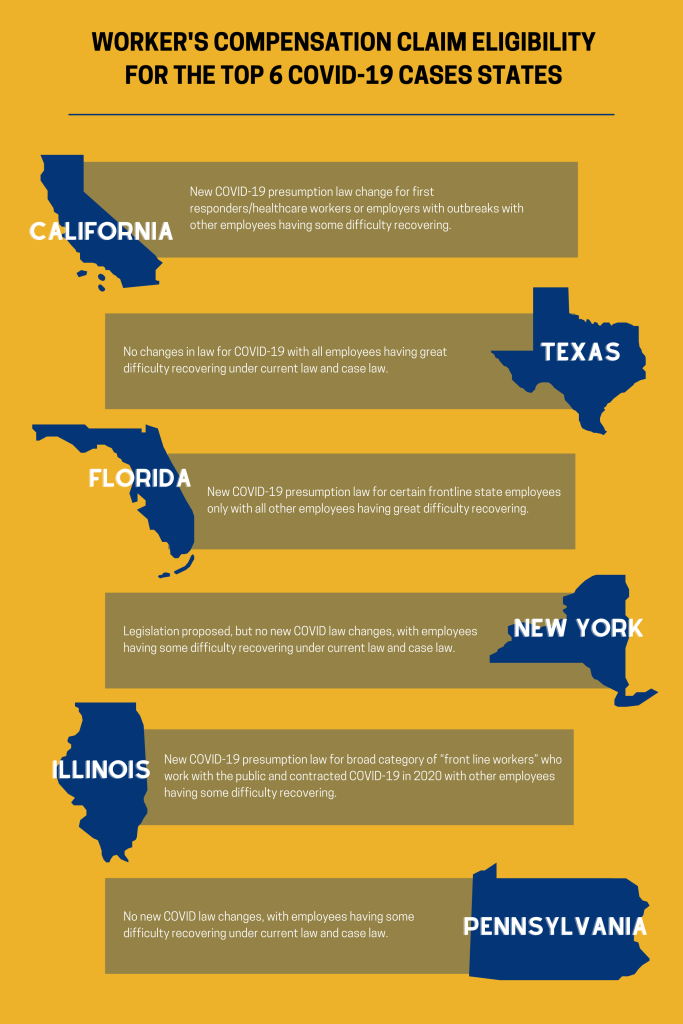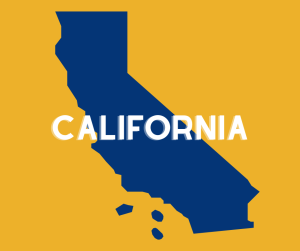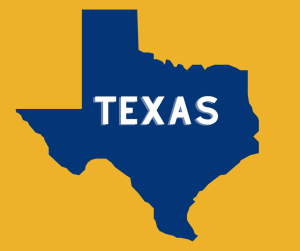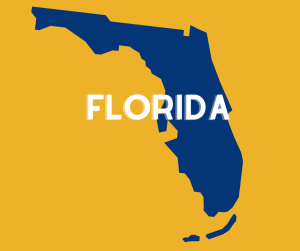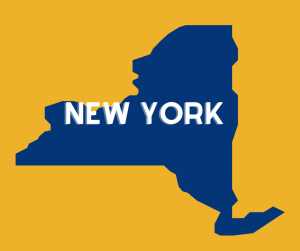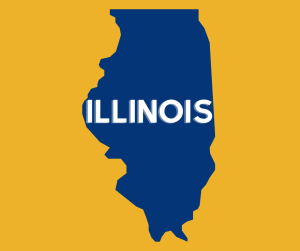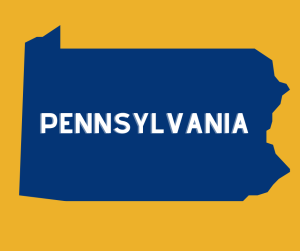All 50 states have workers’ compensation laws in place, but there are differences among the states as to which “work injuries” or “occupational diseases” are covered and how benefits are paid. Many employees and workers may have potential workers’ compensation claims due to contracting the Coronavirus or COVID-19 while at work, including dependents or survivors having potential death or fatal claims due to their spouse or a parent contracting the virus.
As of the date of this article, the top 6 states with reported cases of COVID-19 include California, Texas, Florida, New York, Illinois, and Pennsylvania. However, of these 3 states, only California, Florida and Illinois have changed their law to make it easier to recover for COVID-19 for some employees/occupations, while Texas, New York, and Pennsylvania have made no changes. Below is the analysis of each state:
Jump To:
With regard to receiving workers’ compensation benefits for contracting the Coronavirus, most states will allow all employees to be eligible for workers’ compensation benefits no matter their occupation if they can prove through medical evidence they contracted the virus while working. However, most states are restrictive and will require an additional requirement or burden of proof of two elements: (1) proof of contracting the COVID-19/Coronavirus while working and (2) the employee works in an occupation or job which faces a greater risk of exposure than the general public. Some states are even more restrictive, where they specifically exclude “ordinary diseases of life to which the general public is exposed.” However, even in the most restrictive states of not allowing claims for “ordinary diseases of life to which the general public is exposed,” experienced workers’ compensation law firms predict that occupations such as healthcare industry employees and first responders will have a “very strong argument” that their occupations are covered under the state’s workers’ compensation law. These employees would include occupations such as doctors, nurses, medical technicians, physician assistants, lab techs, nursing home workers and employees in locations such as clinics, hospitals or physician’s offices, paramedics, emergency medical technicians, police officers, firefighters, rescuers, military personnel, and public works employees. Also, some of the states analyzed below have announced NEW changes in the law since the COVID-19 outbreak, granting exceptions for health care industry employees and first responders. A great resource for following workers’ compensation legislation, executive orders and regulatory updates due to COVID-19 is a report published by Oliver Wyman, an international management consulting firm. The report identified 24 states which have made changes to their workers’ compensation acts to deal with COVID-19 exposures as of April 14, 2021. The report was first published on November 23, 2020, and is periodically updated.
Even in more restrictive states where the law has not been changed or amended, other employees in industries or occupations outside of healthcare workers and first responders may also have successful workers’ compensation claims where it could be argued their occupation has a greater risk of COVID-19 exposure as compared to the general public. These occupations could include, among others: pilots, flight attendants, cruise ship employees, traveling employees who are required to travel and have contracted the virus while traveling, cleaning and maintenance employees, pharmacist, pharmacist techs, and even delivery drivers who have contact with employees in the industries mentioned above. In some states analyzed such as Pennsylvania which has not passed any new legislation or regulations due to COVID-19, an article written by our Philadelphia car accident firm, The Pearce Law Firm Personal Injury and Accident Lawyers, P.C. which focuses on personal injuries concluded that in Pennsylvania there remains a relaxed burden of proof that an employee must merely show by a preponderance of the evidence (i.e., that is more likely than not) that he or she contracted or was exposed to the Coronavirus at work through medical evidence (to a reasonable degree of medical certainty) no matter the job or occupation.
What Is Workers’ Compensation? The Basics
Generally, workers’ compensation is a no-fault system designed to pay employees wage loss and medical benefits as a result of an injury or disease that arose out of and in the course and scope of employment. Workers’ compensation also allows for death benefits to survivors or dependents (i.e., spouse, children) of employees who are fatally injured or die from their work injury, work illness, or work disease. Workers’ compensation was designed to be a no-fault system to provide employees a speedy recovery to receive income and medical benefits without having to sue their employer and prove negligence. This generally means that if workers’ compensation is available, an employee’s only remedy against their employer for a work injury or work disease is to file for workers’ compensation benefits rather than to file a tort lawsuit. In most states, employers are able to secure workers’ compensation insurance by purchasing it through private insurance companies (e.g., Travelers, Hartford). Almost every state requires employers to carry workers’ compensation for their employees, even if they have fewer than 10 employees. However, some states like Florida have minimum employment requirements generally ranging from 3 to 5 employees. The National Federation of Independent Business has an excellent resource broken down by the state for determining how many employees a business must have to require workers’ compensation.
Differences in State Workers’ Compensation Laws for Occupational Diseases
Every state has a workers’ compensation law or workers’ compensation act. However, while many basics and fundamentals are similar in every state workers’ compensation law, every state has some differences. One of the major differences in state workers’ compensation laws is which occupational diseases are covered and the burden of proof required for a worker to prove entitlement to workers’ compensation benefits due to an occupational disease or infectious disease contracted at work such as the Coronavirus. These different state approaches have their foundation in the original definition of workers’ compensation requiring a “personal injury by accident” or “accidental injury,” and thus not including occupational diseases. J. Little, T. Eaton & G. Smith, Workers’ compensation: Cases and Materials, Chapter 6 (West 7th ed. 2014). This changed over time, with every state workers’ compensation law now covering occupational diseases. There are various ways occupational diseases are now covered under different state workers’ compensation laws, including having a general definition of occupational diseases in their worker’s compensation statute; having a separate occupational disease law; listing specific various occupational diseases that are covered sometimes with a catch-all provision for non-listed diseases, and allowing coverage for diseases under the normal “injury” or “accident” provision of the workers’ compensation statute sometimes in addition to having a separate occupational disease statute due to court interpretation or amendments to the statute. Larson, Occupational Diseases Under Workmen’s Compensation Laws, University of Richmond Law Review, 9 U. Rich. L. Rev. 87 (1974). However, the most important analysis to determine coverage for infectious diseases like the Coronavirus or COVID-19 is to look at the burden of proof required by a specific state to prove an occupational injury. In this article, we have attempted to divide states into two general categories: more restrictive burden of proof requiring peculiar or increased risk of employment (peculiar/increased risk approach) and less restrictive burden of proof (actual/positional risk approach).
Restrictive Burden of Proof: Peculiar Risk or Increased Risk Approach
Many states have a separate provision in their workers’ compensation statute that carries a different burden of proof for “occupational diseases.” Generally, the burden requires not only that the disease arises out of and in the course and scope of employment, but a second burden for the employee to prove that the occupational disease is characteristic of and peculiar to a particular trade, occupation, process, or employment, with some statutes specifically excluding ordinary diseases of life to which the general public are exposed (i.e., the flu or common cold). In general, under this additional burden of proof for an occupation disease, the worker must show that the illness or disease arose out of or was caused by conditions peculiar to the work and that he or she had an increased risk of contracting the disease as compared to the general public. This has been called the “peculiar risk” or “increased risk” approach or doctrine. 4 Larson’s Workers’ Compensation Law § 52.03 (2019). Under this approach, health care workers and first responders may well be covered, but other occupations may not, a fact acknowledged by insurance industry experts writing in insurance journals, who have stated, “Healthcare workers may be able to prove the necessary peculiarity – being face-to-face with sick people ALL day – to assert a compensable injury.”
Burden of Proof: Actual Risk or Positional Risk Relaxed Burden
Some states like Pennsylvania have had court decisions more liberally interpreted their state workers’ compensation law to cover diseases under the normal “injury” provisions of their workers’ compensation laws which does not carry the additional burden of proof that the job or occupation has an increased or peculiar risk of exposure. Pawlosky v. W.C.A.B., 514 Pa. 450, 525 A.2d 1204 (1987). In these states, courts have declared that an “injury” under a state workers’ compensation act need not arise from an accident or specific physical bodily trauma, but can include a disease not statutorily defined as an “occupational disease.” In these states, the burden would be that the employee shows that it was probable through medical evidence that he or she contracted the Coronavirus or other disease within the course and scope of employment although states may differ as to the medical burdens of proof. In some states, this might be done by simply showing that a co-employee or someone at work was diagnosed with the Coronavirus and the employee had close contact with that person and that this was the most likely exposure the employee encountered. The best evidence would be to identify a specific co-employee or another person at work who was diagnosed with the Coronavirus, and that the employee had frequent contact with this person, with no other evidence of contact with a confirmed contagious person outside of work.
As noted above, about 24 states have changed or amended their workers’ compensation statutes to provide a presumption that COVID-19 was contracted at work generally for specific occupations of first responders and health care workers. However, for employees not covered by these new statutes, the best way to determine which employees may qualify for workers’ compensation benefits if they contract the Coronavirus while working and what burden of proof will be used will be to look at past cases that involved contagious or infectious diseases, including valley fever; Lyme disease, mumps; Amoebic dysentery; Ebola; hepatitis, and tuberculosis.
A State-by-State Analysis of Potential Workers’ Compensation Claims in the Top 6 States With the Most Reported Coronavirus COVID-19 Cases.
California: New COVID-19 Presumption for First Responders/Healthcare Workers or Employers With Outbreaks With Non-Qualifying Employees Having Restrictive Increased Risk Burden but Liberal Interpretation by California Courts
Under California workers compensation law, all employers even those with just one employee must carry coverage. On September 17, 2020, the California Workers’ Compensation Act was amended when Governor Newsom signed SB 1159, which codifies the COVID-19 presumption created by Executive Order N-62-20 and provides rebuttable presumptions that an employee’s illness related to coronavirus is an occupational injury and therefore eligible for workers’ compensation benefits for certain employees. The presumption applies to the following wide class of workers: first responders, health care workers, and employees whose employers have five or more employees, and who test positive for COVID-19 during an outbreak at their specific workplace. The California Department of Industrial Relations sets forth frequently asked questions about the new law on its website.
Aside from the new law giving certain workers a presumption that they contracted COVID-19 at work, defining California as an increased/peculiar risk approach as opposed to an actual/positional risk approach for occupational diseases is difficult. California does not have a separate statute for occupational diseases, but rather became one of the first jurisdictions to expressly cover disease in general terms in 1917 defining injury to include “any disease arising out of the employment.”‘ Charles Lawrence Swezey, Disease as Industrial Injury in California, 7 Santa Clara Lawyer 205 (1967). According to Swezey, California courts have not generally defined occupational disease to the extent other states have done so, but the courts have recognized from the outset that diseases arising out of employment fall into two classes: (1) industrial or occupational disease which is the natural and expected result of a worker following a particular occupation for a considerable period of time, and (2) another disease which is the result of some unusual condition of the employment. Id.
According to an article written before the new law providing a presumption for first responders, health care workers, and others which took effect in September 2020, Attorney Raymond F. Correio noted California courts have distinguished “non-occupational diseases” as being one that is not contracted solely due to work exposure or one that is not related to a particular type of work such as black lung disease suffered by coal miners. Thus, if an employee is not covered under the new law, COVID-19 would be classified as a non-occupational disease. According to Correio, there are numerous cases holding that these non-occupational disease claims such as common colds, the flu, and other similar viruses and diseases are compensable only if it is established by showing a “special exposure” or “increased risk” to the employee due to his or her employment as compared to the general public. This burden has been defined by California courts that the employee’s risk of contracting the disease by virtue of the employment must be materially greater than that of the general public. South Coast Framing, Inc. v. W.C.A.B, 349 P.3d 141, 148, (Cal. 2015) citing Bethlehem Steel Co. v. Industrial Acc. Com. 135 P.2d 153 (Cal 1943)(award upheld to shipyard worker who contracted a contagious eye disease, since he had shown “the epidemic in the shipyards constituted a special exposure” in that the disease was more common at his place of employment than among the public). Thus as pointed out by Correio, there have been numerous cases where an employee has established the “special exposure” or “increased risk” from a disease to be successful in a California workers’ compensation case, including flu (Hospital employee working as a steward, had increased risk of contracted influenza with “five to eight times as great” likelihood of exposure while in the hospital as while outside); Hepatitis B and C (A police officer exposed to drug addicts and paraphernalia had increased risk of contracted Hepatitis B); and Valley Fever/Coccidiomycosis (increased exposed to fungus and dirt at work). An excellent article on these “Valley Fever” cases, AB 203: How Global Climate Change and Valley Fever Impact Workers’ Compensation was originally published in California’s Workers’ Compensation Quarterly 2019, Vol. 32, No. 4. Of particular note, the article cites to recent California Workers’ Compensation Appeal Board cases holding that an employee is not required to establish medical certainty, they are required to establish they contracted the disease (e.g. Valley fever) to a reasonable medical probability.” Abernathy v. Harris Woolf California Almonds, Zenith Ins. Co., 2017 Cal. Wrk. Comp. P.D. LEXIS 231, Cruz v. Hall Mgmt. Corp., 2019 Cal. Wrk. Comp. P.D. LEXIS 29.
In fact, one of the leading workers’ compensation blogs, Larson’s Spotlight states that at least one of the Valley fever cases, “seems to represent . . . a transition from the peculiar – to the actual-risk approach.” citing Pacific Employers Ins. Co. v. Industrial Acci. Com., 122 P.2d 570 (Cal. 1942)(in that the Court stated, “the injuries [contracting Valley fever] suffered to be compensable need not be of the kind anticipated by the employer or peculiar to the employment”).
In summary, many first responders, health care workers, and other employees who test positive for Coronavirus during “an outbreak” will receive the new presumption and should be successful in their workers’ compensation claims with the signing of SB 1159. Other employees not covered under the new law will have to look at other infectious disease cases, but also may be successful. Because of the vast amount of case law on many infectious diseases, including Valley Fever and California court’s arguably liberal interpretation in some of its cases regarding causation, California appears to be a state where employees will have great success in bringing COVID-19 workers’ compensation claims.
Texas: Restrictive Increased Risk Burden and No New Law Change for COVID-19
Texas is one of the few states where workers’ compensation insurance is optional as most employers can “opt-out” of coverage. However, an employee could potentially sue the employer in tort for negligence if the employer opts out of workers’ compensation, so many employers do carry workers’ compensation insurance.
Texas is a peculiar risk state for occupational diseases and most workers outside the healthcare industry/first responders will find it difficult to receive workers’ compensation benefits if they contract COVID-19 even though suspecting it from work. In order to be compensable as an “occupational disease,” the disease must arise out of and in the course of employment that causes damage or harm to the physical structure of the body. However, an occupational disease excludes an ordinary disease of life to which the general public is exposed outside of employment, “unless the disease is [one that is] incident to a compensable injury or occupational disease.” TEX.REV.CIV.STAT.ANN. art. 8306 sec. 20 (Vernon Supp.1989). To establish an occupational disease, there must be probative evidence of a causal connection between the claimant’s employment and the disease, i.e., the disease is indigenous thereto or present in an increased degree. Home Insurance Co. v. Davis, 642 S.W.2d 268, 269 (Tex. App.—Texarkana 1982, no writ); INA of Texas/now CIGNA Ins. Co. of Texas v. Adams, 793 S.W.2d 265, 267 (Tex. App. 1990).
Claimants would likely face difficulties establishing a causal link between their employment and the Coronavirus; that is, most workers will be unable to establish that COVID is “indigenous” to their type of work or that risk of infection exists at an increased degree in their employment. See e.g., Jackson and Carsey, Ebola Coverage: A Primer 13 J. Tex. Ins. L. 17 (2015).
The difficulty in Texas of claimants being successful in proving entitlement to workers’ compensation benefits for contracting an infectious disease at work has been shown in the case law. The Texas Supreme Court addressed unusual infections as occupational diseases in Schaefer v. Texas Employers’ Insurance Association 612 S.W.2d 199 (Tex. 1980)(evidence that the particular strain of tuberculosis bacteria from which claimant suffered was not identified, plus testimony that the manner in which the disease was transmitted to the claimant was unknown, rendered the opinion of claimant’s physician not legally sufficient as it was not based upon reasonable medical probability). In short, other than possibly first responders and healthcare workers, it appears it will be difficult for employees to receive workers’ compensation benefits under Texas law, and the insurance industry is reporting most claims in Texas are being denied by the insurance industry.
Florida: New COVID-19 Presumption for Certain Frontline State Employees/Occupations With Non-Qualifying Employees Having Restrictive Increased Risk Burden but Liberal Interpretation by Florida Courts
Florida does have a minimum employment requirement for non-construction employers. For non-construction employers, workers’ compensation insurance is required when a business has four or more employees, either full-time or part-time. On March 20, 2020, the Chief Financial Officer of the State of Florida issued a directive (Directive 2020‐05) that creates a presumption COVID-19 was contracted due to employment for frontline state employees (defined liberally as including law enforcement officers, firefighters, emergency medical technicians or paramedics, corrections officers and state employees working in the healthcare field).
If an employee is not a state frontline employee, Florida is a peculiar risk state for occupational diseases, and employees not defined above as frontline state employees may find it difficult to prove workers’ compensation benefits for contracting COVID-19. Subsection 440.151(2), Florida Statutes provides: “Whenever used in this section the term “occupational disease” shall be construed to mean only a disease which is due to causes and conditions which are characteristic of and peculiar to a particular trade, occupation, process, or employment, and to exclude all ordinary diseases of life to which the general public is exposed, unless the incidence of the disease is substantially higher in the particular trade, occupation, process, or employment than for the general public. “Occupational disease” means only a disease for which there are epidemiological studies showing that exposure to the specific substance involved, at the levels to which the employee was exposed, may cause the precise disease sustained by the employee.”
Of significant note, on October 1, 2003, the legislature made several significant changes to Section 440.151, which included the additional definition of occupational disease to mean “only a disease for which there are epidemiological studies showing that exposure to the specific substance involved, at the levels to which the employee was exposed, may cause the precise disease sustained by the employee.” Thus, case law interpreting the statute before 2003 must be scrutinized carefully.
Infectious diseases have been difficult to prove. See Florida State Hospital v. Potter, 391 So.2d 322 (Fla. 1st DCA 1981)(court held that tuberculosis is an ordinary communicable infectious disease to which the general public is exposed and because there was no evidence that workers at the hospital where the claimant worked had a substantially higher rate of the disease than the general public, and because there was also no evidence that the claimant’s tuberculosis was due to causes and conditions which were characteristic of and peculiar to the claimant’s employment, the court reversed the award of benefits); Lake v. Irwin Yacht & Marine Corp., 398 So.2d 902, 904 (Fla. 1st DCA 1981)(court formulated the test for recovery for an occupational disease including “if the disease is an ordinary disease of life, the incidence of such disease must be substantially higher in the particular occupation than in the general public). Thus, in Florida, while Hepatitis B may be an occupational disease for a hospital laboratory technician, Wuesthoff Memorial Hospital v. Hurlbert, 548 So.2d 771 (Fla. 1st DCA 1989), it may not be an occupational disease for a person in another line of work. According to Florida courts, the issue of compensability is one of proof and is not so much a question of definition. Glasrock Home Health Care v. Leiva, 578 So. 2d 776, 779 (Fla. Dist. Ct. App. 1991).
Interestingly, in proving “the incidence of such disease must be substantially higher in the particular occupation,” a 1989 Florida court decision held authoritative information from the Center for Disease Control (CDC) can be utilized to support a claim or defense of “occupational disease.” Wuesthoff Memorial Hospital. Hurlbert, 548 So. 2d 771 (Fla. 1st DCA 1989).
In summary, unless an employee is covered under the new directive for frontline state employees, other than possibly first responders and healthcare workers in the private industry, it appears it will be difficult for employees to receive workers’ compensation benefits under Florida law. In fact, the Wall Street Journal reported COVID-19 workers’ compensation claims from primarily private-sector employees were being denied roughly 56% of the time in Florida.
New York – Relaxed Burden but No New Law Change
All employers who have at least one employee must purchase workers’ compensation in New York. There are a number of New York cases that have interpreted the New York statute to cover diseases under the normal “accident personal injury” provisions and thus allowing the normal preponderance of the evidence burden of proof rather than an “occupational injury” peculiar risk analysis. According to a legal treatise on New York Workers’ Compensation Law, “In addition to those diseases set forth in the statutes, an employee may also recover compensation for a disease to which Section 3(2) does not apply if the disease is an accidental personal injury within the meaning of N.Y. Work. Comp. Law § 2(7).” 1 New York Workers’ Compensation Handbook § 3.02 (2020). Examples include: a correction officer contracted tuberculosis from exposure to persistent coughing by a tubercular inmate in claimant’s presence for approximately four months – Middleton v. Coxsackie Correctional Facility, 341 N.E.2d 527 (1975); Malignant tertian malaria was caused by the sting of a certain species of mosquito – Lepow v. Lepow Knitting Mills, 43 N.E.2d 450, 452 (1942); a teacher contracted mumps after exposure to school children during an epidemic – McDonough v. Whitney Point Cent. Sch., 15 A.D.2d 191, 222 N.Y.S.2d 678 (3d Dept. 1961); poliomyelitis occurred after a sneeze in claimant’s face by a fellow nurse suffering from said disease – Gardner v. New York Medical College, 280 A.D. 844, 113 N.Y.S.2d 394 (3d Dept. 1952), aff’d, 305 N.Y. 583, 111 N.E.2d 644 (1953); scarlet fever was contracted by a matron in direct contact with children suffering from this disease – Gaites v. Soc’y for the Prevention of Cruelty to Children, 251 A.D. 761, 295 N.Y.S. 594 (3d Dept. 1937), aff’d, 277 N.Y. 534, 13 N.E.2d 461 (1938). See 1 New York Workers’ Compensation Handbook § 3.02 (2020). In these cases, the diseases were able to be shown from a single definite exposure and therefore could be seen to be more like an accident than an occupational disease. Id. Thus, if an employee could show that he or she was exposed from a single definite exposure while working (within the course of employment), a relaxed burden of proof appears applicable in New York. However, it appears the battle will be over the medical evidence. As is noted in an article by a defense workers’ compensation law firm in New York citing past cases, “past claims for exposure to infectious diseases have been disallowed where claimants failed to establish exposure to the disease in the course of employment – including via medical evidence of consistency between the incubation period, the alleged date of exposure, and the onset of symptoms – and the cause of the disease was common in the community such that exposure could have occurred everywhere, all of which rendered medical opinions of causal relationship speculative.”
UPDATE as of April 2021: Although there is some legislation pending to amend New York’s Workers’ Compensation statute to make COVID-19 an occupational disease to allow for a presumption of causation for first responders, essential and health care workers, and others, no legislation has been passed to date. The New York Workers’ Compensation Board issued guidance stating that employees who contract COVID-19 while at “work in an environment where exposure risks are significantly higher” are more likely to be eligible for benefits. On March 18, 2020, Governor Cuomo signed emergency legislation guaranteeing job protection and pay for New Yorkers who have been quarantined as a result of the novel coronavirus, or COVID-19, providing job protection, employer-provided paid sick leave, and additional disability and paid family leave benefits for employees who cannot work or telework due to COVID-19 related reasons. See helpful chart outlining new employee benefits.
Illinois: New COVID-19 Presumption for Broad Category of “Front Line Workers” Who Work With the Public and Contracted COVID-19 Between March 9, 2020, and December 31, 2020, With Non-Qualifying Employees Having Restrictive Increased Risk Burden but Liberal Interpretation by Illinois Courts
All employers in Illinois must carry workers’ compensation, even if the employer only has one employee. On June 5, 2020, the Illinois Workers’ Compensation Act was amended to provide a presumption of causation for certain categories of “front line workers” who contract COVID-19 to obtain workers’ compensation benefits. As noted by the Taft Law Firm, “the new law accomplishes through legislation what the state had previously tried — and failed — to accomplish through regulation.” The editor of the Larson treatise, Tom Robinson had reported on his blog that as of April 13, 2020, the Workers’ Compensation Commission of Illinois held an emergency meeting to consider and pass an emergency amendment to its Rules of Evidence to try and alter the rules of evidence to provide this presumption to certain workers. However, as noted by the Taft Firm, “the emergency rule was quickly challenged in court, and the Workers’ Compensation Commission withdrew it on April 27, 2020.” The new law, formerly HB 2455 established a presumption to a broad category of “front line workers” receiving a COVID-19 diagnosis between March 9, 2020, and December 31, 2020, who work in one of the “essential businesses” listed in Governor Pritzker’s Stay at Home Order. The presumption only applies to employees who “encounter members of the general public” or “work in employment locations of more than 15 employees.” For employees who do not interact with the general public, they will not receive the presumption unless they work with 15 or more employees at their place of business.
For workers not covered by the presumption, it will be more difficult to receive workers’ compensation for COVID-19. Illinois is a peculiar risk state regarding occupational diseases and thus most workers outside the healthcare industry (and those not covered by the new law) may find it difficult to receive benefits. The occupational disease statute states, “A disease shall be deemed to arise out of the employment if there is apparent to the rational mind, upon consideration of all the circumstances, a causal connection between the conditions under which the work is performed and the occupational disease. The disease need not to have been foreseen or expected but after its contraction, it must be apparent to have had its origin or aggravation in a risk connected with the employment to have flowed from that source as a rational consequence.” 820 ILCS 310/1(d). Case law has seemed to soften this burden. The Supreme Court of Illinois has held “nothing in the statutory language requires proof of a direct causal connection. Sperling v. Industrial Commission, 129 Ill.2d 416, 421, 544 N.E.2d 290, 135 Ill.Dec. 794 (1989). According to an exhaustive review of all 50 states on workers’ compensation liability for COVID-19 authored by the employment law firm of Wilson Elser, the Illinois definition “provides a lower burden of proof than one would see in any other type of case, where an expert would be required to show the employee contracted the disease from work exposures rather than a family member or random contact while not on the clock.” Case law has held, “A causal connection may be based on a medical expert’s opinion that an accident ‘could have’ or ‘might have’ caused an injury.” Omron Elecs. v. Illinois Workers’ Comp. Comm’n, 2014 IL App (1st) 130766WC, ¶ 38, 21 N.E.3d 1245 (quoting, Consolidation Coal Co. v. Industrial Comm’n, 265 Ill. App. 3d 830, 839 (1994)).
Thus, it can be argued that given this lower burden of proof once it can be shown the job increases risk, it is likely the “rational mind test” could find a connection with employment and contracting COVID-19 and provide for compensation for the worker. See the above-mentioned Wilson Elser’s article.
Pennsylvania: No New Law or Presumption for COVID-19, but Relaxed Burden of Actual or Positional Risk
In Pennsylvania, every employer is required to carry workers’ compensation insurance no matter the number of employees. There have been no executive orders or amendments to the Pennsylvania Workers’ Compensation Act regarding COVID-19 at the time of this writing. However, Pennsylvania is unique in covering occupational diseases. In Pennsylvania, diseases that are contracted by an employee while working are covered both under the Workers’ Compensation Act, Section 301(c)(1), and the Occupation Disease Act, Sections 301(c)(2) and 108. Pennsylvania is one of the few states where an employee can recover under two theories (i.e., “disease as an injury” or “occupational disease”) to receive workers’ compensation benefits. Pittsburgh Bd. of Educ. v. WCAB (Perkins), 529 A.2d 1166 (Pa. Cmwlth. 1987) citing Pawlosky v. W.C.A.B. 473 A.2d 260 (Pa. Cmwlth. 1984) affirmed 525 A.2d 1204 (Pa. 1987); See also Temple Univ. v. WCAB (INA), 588 A.2d 63 (Pa. Cmwlth. 1991)(employee can proceed under both theories at the same time).
Since the landmark decision of Pawlosky in 1987 by the Pennsylvania Supreme Court, an employee can recover under a “disease as an injury” theory under Section 301(c)(1) as opposed to or in addition to the occupational disease theory. In an exhaustive blog article analyzing workers’ compensation claims for infectious diseases in Pennsylvania written our law firm proudly serving injured victims throughout Philadelphia and the surrounding area, The Pearce Law Firm, Personal Injury and Accident Lawyers, P.C. details many infectious diseases claims to be successful in Pennsylvania, including “disease” cases such as tuberculosis, influenza, and Lyme Disease where exposure could have also occurred both inside of work or outside of work. Pennsylvania, whose statute does not require a showing of the added risk, has produced a case in which even a momentary exposure to a rare disease was sufficient to establish work connection. In City of New Castle v. W.C.A.B. (Sallie), 546 A.2d 132 (Pa. Cmwlth. 1988), an infectious disease contracted at work from a co-worker was found compensable with sufficient medical evidence to establish the claim. In the New Castle case, a supervisor for the city of New Castle died from meningococcal sepsis, which the supervisor alleged he contracted when he kissed a co-worker (who was a non-symptomatic carrier of the disease) on the cheek at work wishing her “goodwill” as she was leaving for maternity leave. First, the court held the injury occurred in the course and scope of employment because he was at work when he kissed his co-worker and this act was merely a “harmless act of goodwill” toward a co-employee. Next, following the reasoning of the treatise, Larson, Workmen’s Compensation Law § 8:50 (1984), the court held that, because the Pennsylvania Workers’ Compensation Act did not require added or peculiar risks but simply compensates for injuries arising within the course of employment, the ”injury” was compensable.
In summary, a thorough review of Pennsylvania cases, especially at the Pennsylvania Workers’ Compensation Appeal Board level, show that if Claimant’s medical expert can testify that in his or her professional opinion the employee contracted the disease from work and is found credible by the workers’ compensation judge that evidence has been upheld at the Workers’ Compensation Appeal Board level and at the appellate level. Thus, Pennsylvania may be a state where claimants have success in bringing COVID-19 workers’ compensation cases despite Pennsylvania not having a new amendment or change in its workers’ compensation law for a COVID-19 presumption for any workers.








